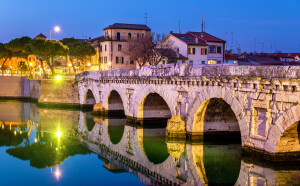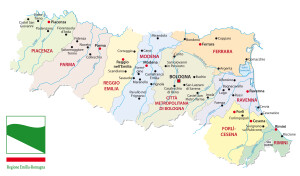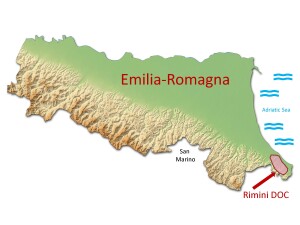The province of Rimini is tucked into the southern corner of the region of Emilia Romagna, bordering the Adriatic Sea. It is just south of the province of Forlì-Cesena and wraps around the tiny enclave of San Marino (to the south); the rest of the southern border is shared with the region of Marches.
Its capital city—also named Rimini—is recognized as one of the leading beach resorts of all of Italy. The city was founded by the Romans in 268 BCE and is well-known for its numerous Roman and Renaissance monuments (including a Roman amphitheater) and museums (covering artifacts both ancient and modern). The city also features in a number of famous films—which might be expected, as it is the birthplace of Federico Fellini himself.
The province of Rimini has produced wine since the Roman times and continues to produce a range of wine and wine styles—some from locally specific grape varieties rarely seen outside of the area. The large Colli di Rimini DOC was created in 1996 and covers an area along the coastal plain and into the foothills of the Alps.
NEWS FLASH (for wine students): The name of the Colli di Rimini appellation was recently changed (as of September 2022) to Rimini DOC.
The Rimini DOC is approved for two basic styles of blended wine—bianco (white) and rosso (red)—as well as four specific varietals. These are discussed below:
- Rimini Bianco: This is a dry, light- to medium-bodied white wine produced using a minimum of 30% Trebbiano. Up to 60% may comprise Bombino Bianco or Sangiovese (vinified as a white wine); the remainder (up to 10%) may be any white grape suitable for the region.
- Rimini Rosso: Rimini Rosso is a dry, medium- to full-bodied wine based on (at least 30%) Sangiovese. It may contain up to 60% Cabernet Sauvignon, Cabernet Franc, Merlot, and/or Syrah. Up to 10% of the blend may comprise Alicante, Montepulciano, Petit Verdot, and/or Rebo (a Merlot X Teroldego cross).
- Rimini Cabernet Sauvignon: This is a dry, medium- to full-bodied red wine based on a minimum of 85% Cabernet Sauvignon. (A super-Emilian, perhaps?)
- Rimini Sangiovese: This is a dry, medium- to medium-plus-bodied red wine based on a minimum of 85% Sangiovese.
-
Rimini Biancame: This is a dry, medium-bodied white wine produced using a minimum of 85% Biancame. Biancame is a rare grape—it is estimated there are only 5,000 acres/2,080 hectares planted worldwide; most of these are found in the area around Marches and Emilia-Romagna. It is sometimes known as Bianchello, and as such is the star of the (quite obscure) Bianchello del Metauro DOC of northern Marches.
- Rimini Rebola: This white wine—which may be produced either as a dry wine or a sweet wine (via the passito/dried grape production process)—is made using a minimum of 85% Grechetto Gentile. Grechetto Gentile is native to Emilia-Romagna, also known as Grechetto di Todi, formerly known as Rebola, and known in certain appellations as Pignoletto.
Alas, unless you are in Italy, it may be difficult to find wine from the Rimini DOC. Sounds like a great excuse for a road trip!
References/for more information:
- Extract from the EU Journal-Name Change Rimini DOC
- Rimini DOC-Name Change-Italy Ministry of Agriculture
- Disciplinaire-Rimini DOC
- Click here for a wine map of Emilia-Romagna, via Federdoc
Post authored by Jane A. Nickles…your blog administrator: jnickles@societyofwineeducators.org


